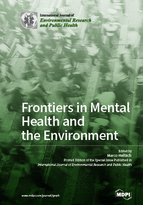Frontiers in Mental Health and the Environment
A special issue of International Journal of Environmental Research and Public Health (ISSN 1660-4601).
Deadline for manuscript submissions: closed (30 August 2018) | Viewed by 71319
Special Issue Editor
Interests: spatial and spatiotemporal analyses; computational urban geography; GIS modeling; real estate economics; active transportation; built and natural environment; health geography
Special Issues, Collections and Topics in MDPI journals
Special Issue Information
Dear Colleagues,
One out of five grown-ups suffered from a mental disorder within the past year, on a global scale. With a lifetime prevalence of two out of seven adults, mental disorders will remain a leading cause of disease burden (see Steel Z et al. The global prevalence of common mental disorders: a systematic review and meta-analysis 1980–2013. Int. J. Epidemiol. 2014, 43(2): 476–493). While mental disorders have devastating consequences for people’s quality of life, they also represent striking challenges for health systems as a whole. Thus, the reduction of mental disorders is a health priority in both developed but also developing countries.
Past research has well-documented that mental disorders emerge as a complex interplay between genetic, psychological, and lifestyle factors, among others. However, throughout a day and over the life course, humans are continuously exposed to social and physical environments including green space, noise, air pollution, etc. Such environmental factors have received scant attention thus far and our existing understanding is tentative, partly inconclusive, and calls for more research dealing with which, how, and to what extent environmental exposures, individually or in combination, affect mental health.
To address this research gap, we organizing a Special Issue on Mental Health and Environmental Exposures in the peer-reviewed scientific journal the International Journal of Environmental Research and Public Health. In order to initiate and further stimulate discussions on this topic, we invite original research, methodological papers, reviews, as well as meta-analyses related to the entire spectrum of mental disorders (e.g., depression, schizophrenia). In addition, we will also feature papers documenting how scientific findings translate into prevention strategies, health policies, and clinical practices.
Complementing traditional health and epidemiological research, significant contributions can be expected from transdisciplinary approaches integrating health (register) data, increasingly available environmental data in tandem with geotechnologies (e.g., geographic information systems) and cutting-edge data analytics (e.g., machine learning, Bayesian spatial and space-time models). This Special Issue is of great interest to both scientific communities and policy-makers. We hope that the contributions will support evidence-based public health policies in the long term.
Dr. Marco Helbich
Guest Editor
Manuscript Submission Information
Manuscripts should be submitted online at www.mdpi.com by registering and logging in to this website. Once you are registered, click here to go to the submission form. Manuscripts can be submitted until the deadline. All submissions that pass pre-check are peer-reviewed. Accepted papers will be published continuously in the journal (as soon as accepted) and will be listed together on the special issue website. Research articles, review articles as well as short communications are invited. For planned papers, a title and short abstract (about 100 words) can be sent to the Editorial Office for announcement on this website.
Submitted manuscripts should not have been published previously, nor be under consideration for publication elsewhere (except conference proceedings papers). All manuscripts are thoroughly refereed through a single-blind peer-review process. A guide for authors and other relevant information for submission of manuscripts is available on the Instructions for Authors page. International Journal of Environmental Research and Public Health is an international peer-reviewed open access monthly journal published by MDPI.
Please visit the Instructions for Authors page before submitting a manuscript. The Article Processing Charge (APC) for publication in this open access journal is 2500 CHF (Swiss Francs). Submitted papers should be well formatted and use good English. Authors may use MDPI's English editing service prior to publication or during author revisions.
Keywords
- mental disorders
- epidemiology
- exposures
- risk assessment
- environments
- neighborhood effects
- activity pattern
- life course
- inequalities
- environmental data
- modelling
- geotechnologies
- GIS
- data analytics






